Cast Iron Peach Cobbler
This classic Southern dessert is made with fresh peaches and a rich, biscuit topping that bakes to golden-brown perfection. What makes this recipe truly special is the cast iron skillet, which gives the cobbler a unique, rustic flavor that is hard to replicate with any other cooking method. Trust me when I say that this recipe is fan-freaking-fantastic and you won’t be able to resist the juicy peaches and golden brown biscuit topping that come together in every bite!
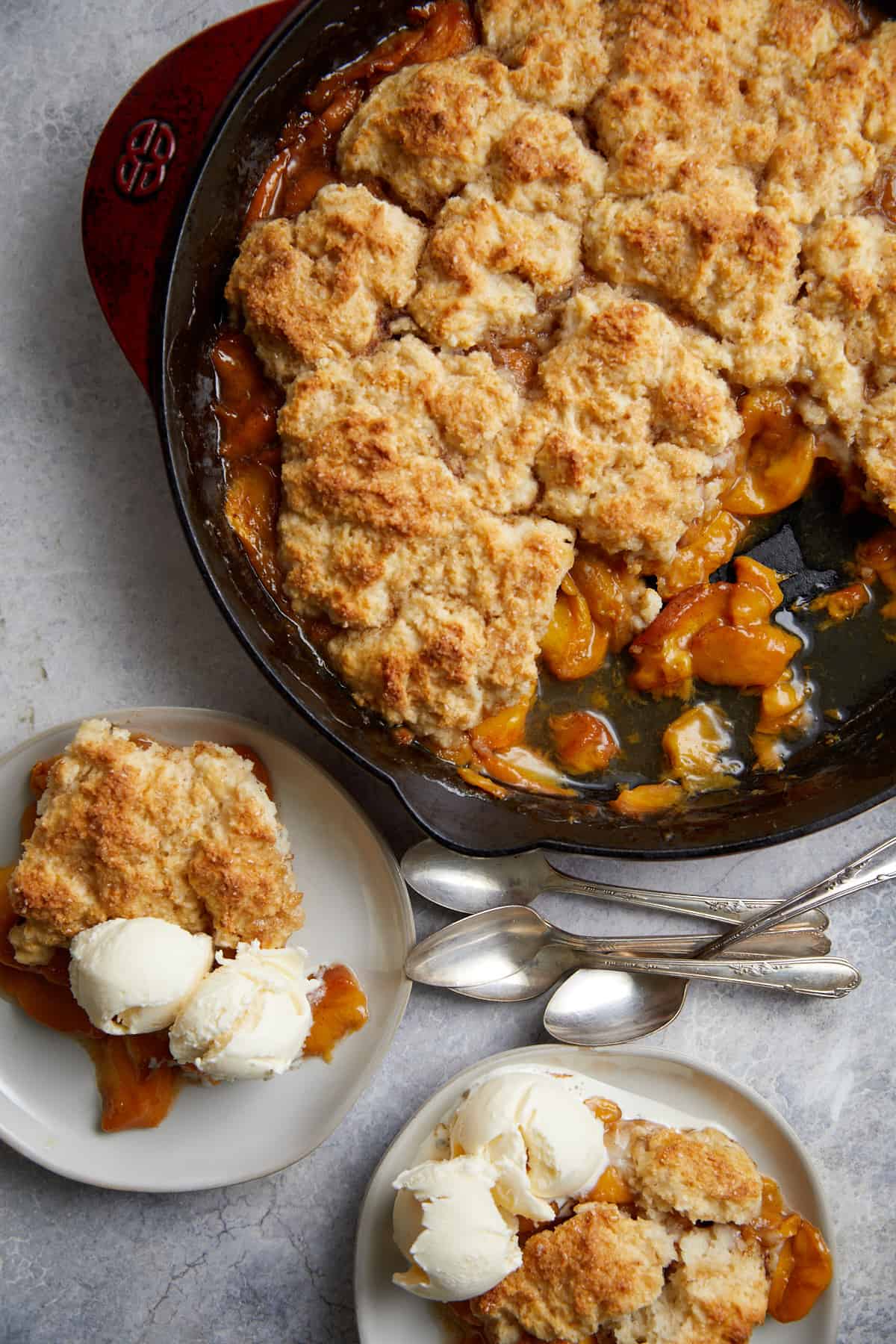
Save this Recipe!
I got A LOT of peaches at my local farm. I bought their “seconds” which are peaches that may have a little bruising or other deficiency. But, are still edible of course, and great to use for desserts. I took them home, peeled them, sliced them, and froze them in batches. So, you are now going to see several peach desserts on this site like this peach cobbler pound cake. And, I have to say that fruit desserts are my ultimate favorite type of dessert, and a great peach cobbler with a side of vanilla ice cream, well you can’t get much better!
INGREDIENTS NEEDED
The recipe is simple to make and requires just a handful of ingredients, making it a great option for those looking for an easy yet impressive dessert. Serve it warm with a scoop of vanilla ice cream, and you’ll have a dessert that will satisfy any sweet tooth. Here’s what you will need:
- Sliced Peaches: I recommend using fresh peaches that are at their peak in season. Go for ones that are slightly soft to the touch. They shouldn’t be super hard, but also not too squishy or overly soft. You will need 7-8 ripe peaches (about 6 cups of slices, 3 pounds). White or yellow peaches can be used. You could also use frozen peaches, you will want to thaw them slightly so you can mix in ingredients. I did not try canned peaches for this recipe.
- Sugar. you’ll need a 1/2 cup of sugar for the peaches and 5 tablespoons for buttermilk biscuits. You may want to add more sugar to your peaches depending on their sweetness.
- Vanilla, allspice, nutmeg and salt: all add flavor to the peaches.
- Tapioca starch: I like using tapioca starch because it creates a delicate, transparent gel that avoids being unpleasantly gloppy. I recommend Bob’s Red Mill brand. If you would rather use cornstarch, then use 2 tablespoons.
- Butter: I used unsalted butter which I use in the majority of baking so you can control the salt. You will use butter for the biscuit topping.
- Flour: all-purpose flour works best in this recipe.
- Buttermilk: Buttermilk is often used in biscuit recipes because it adds a rich and tangy flavor to the dough just like in this pumpkin bread with cream cheese icing. Its acidity also reacts with the baking powder, causing the biscuits to rise and become fluffy.
- Leavening essentials: a combination of baking powder, and baking soda ensures that the biscuit topping bakes properly.
- Turbinado sugar: provides a crunchy topping to the biscuits.
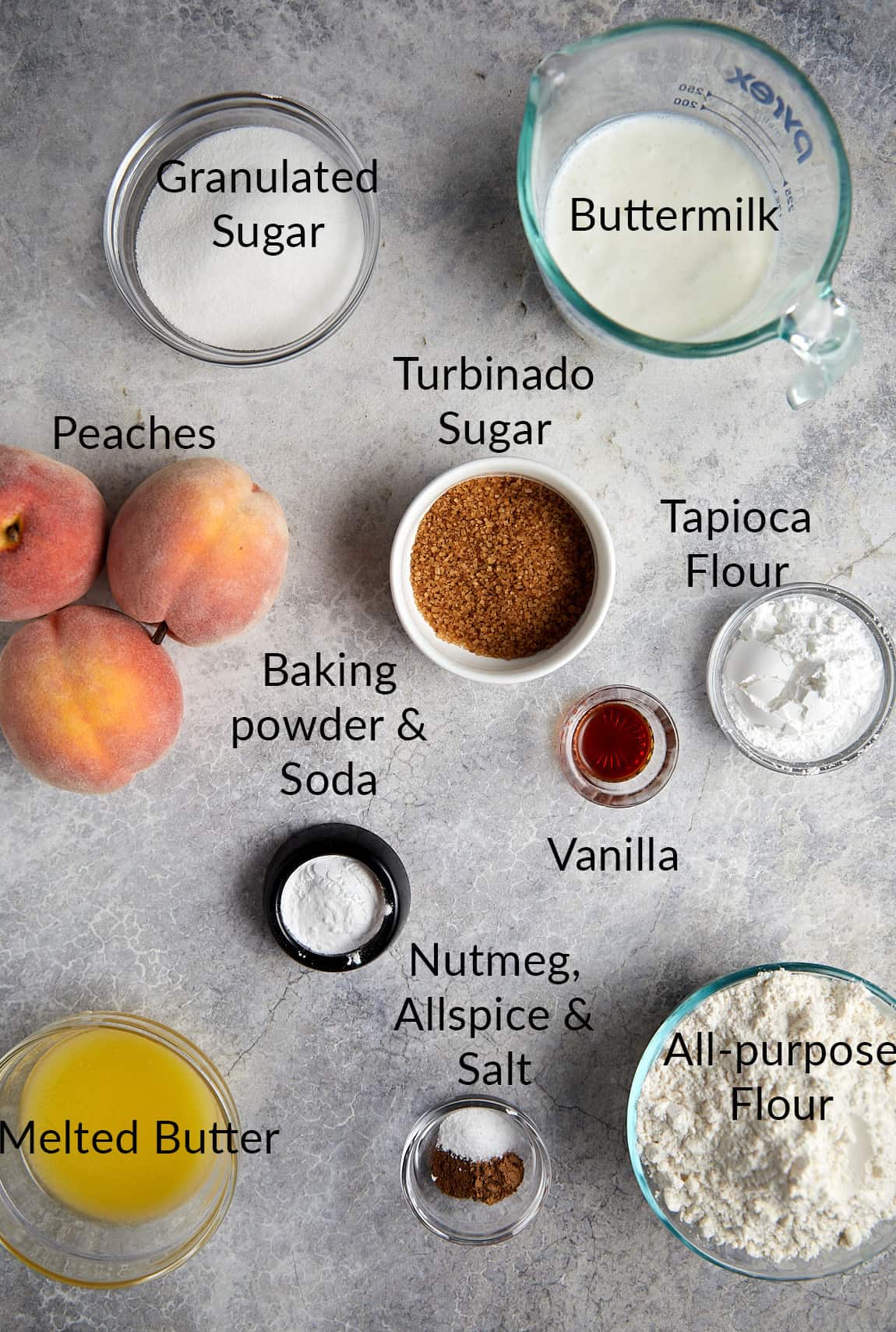
HOW TO MAKE THIS DESSERT
The buttermilk biscuit topping is a breeze to prepare, and the filling only requires a few ingredients. It’s amazingly straightforward but oh-so-rewarding. If you need a summary of the steps, check out the quick guide below, or head to the recipe card at the end of the article for more detailed instructions.
- Flavor Peaches. Mix the peaches with sugar, tapioca starch, vanilla, allspice, nutmeg, and salt together in a medium-sized bowl. Transfer the mixture to a 12-inch cast-iron skillet.
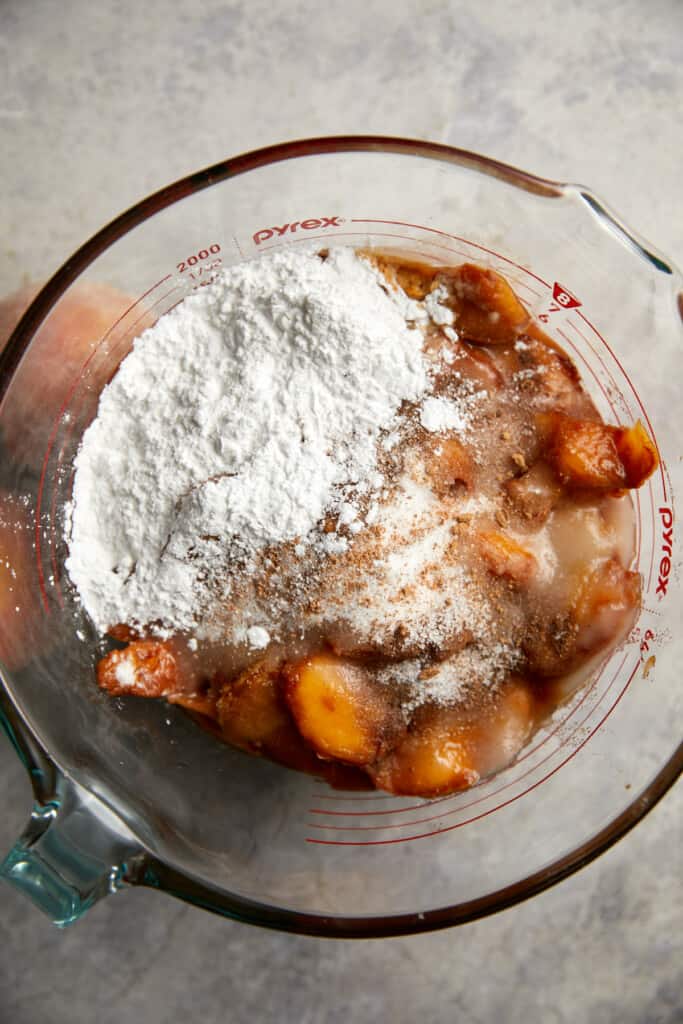
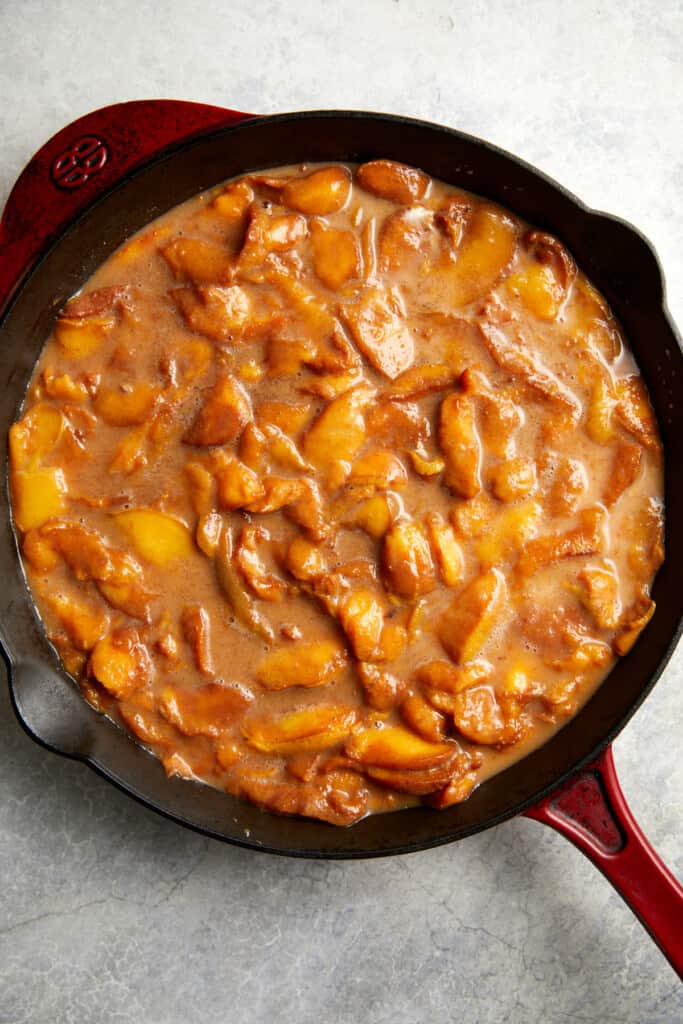
- Whisk the dry ingredient: Whisk flour, granulated sugar, baking powder, baking soda, and salt together in a medium bowl.
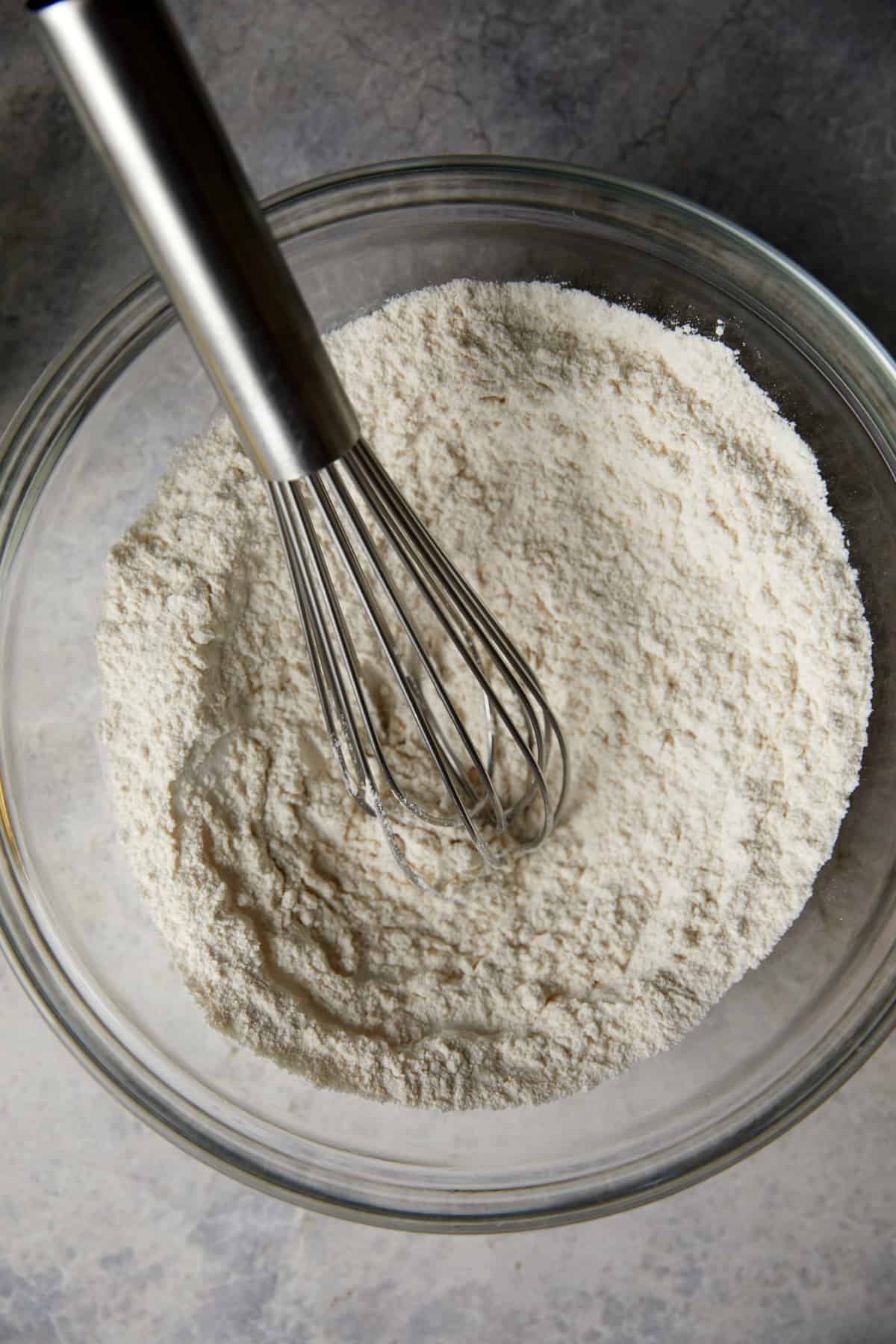
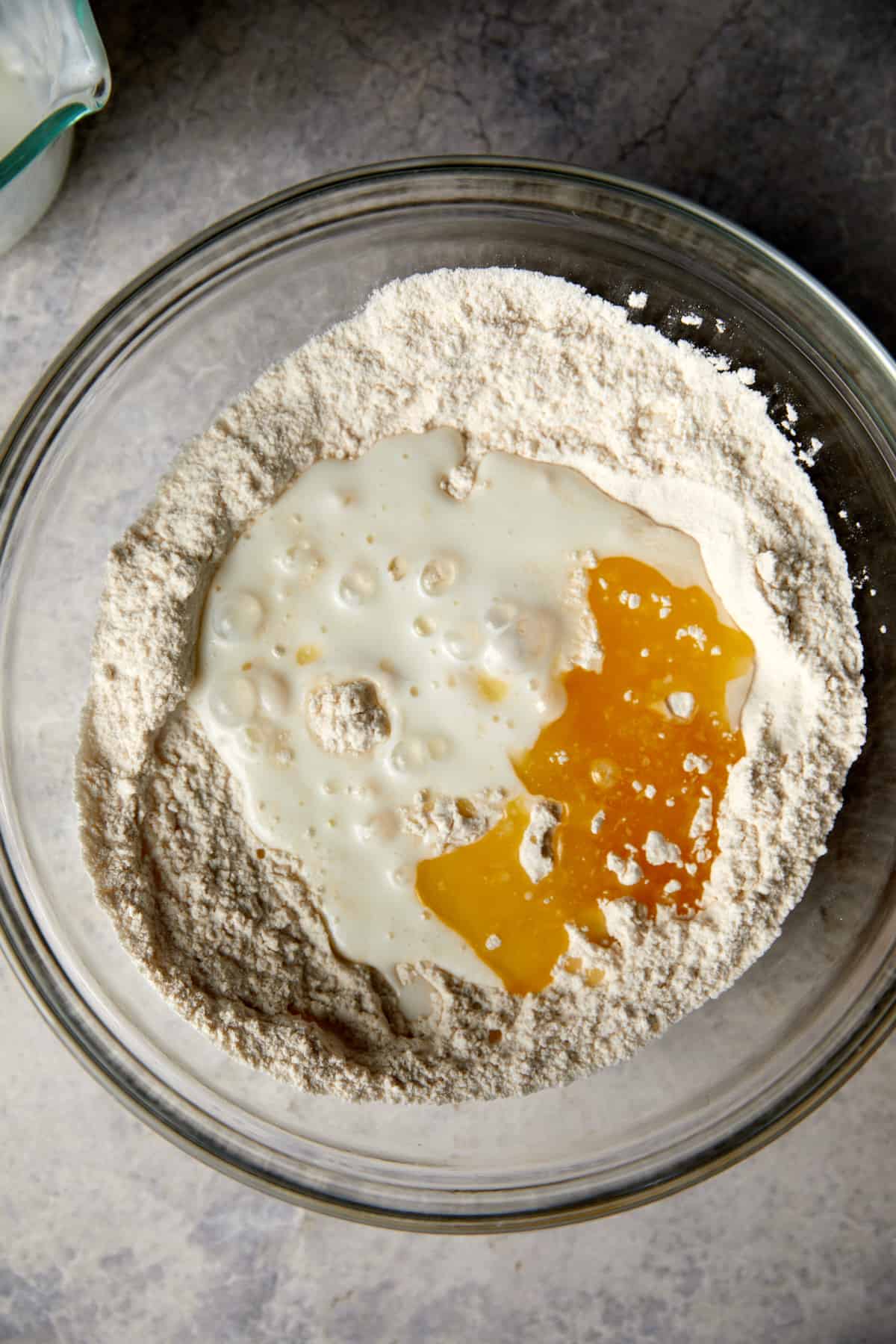
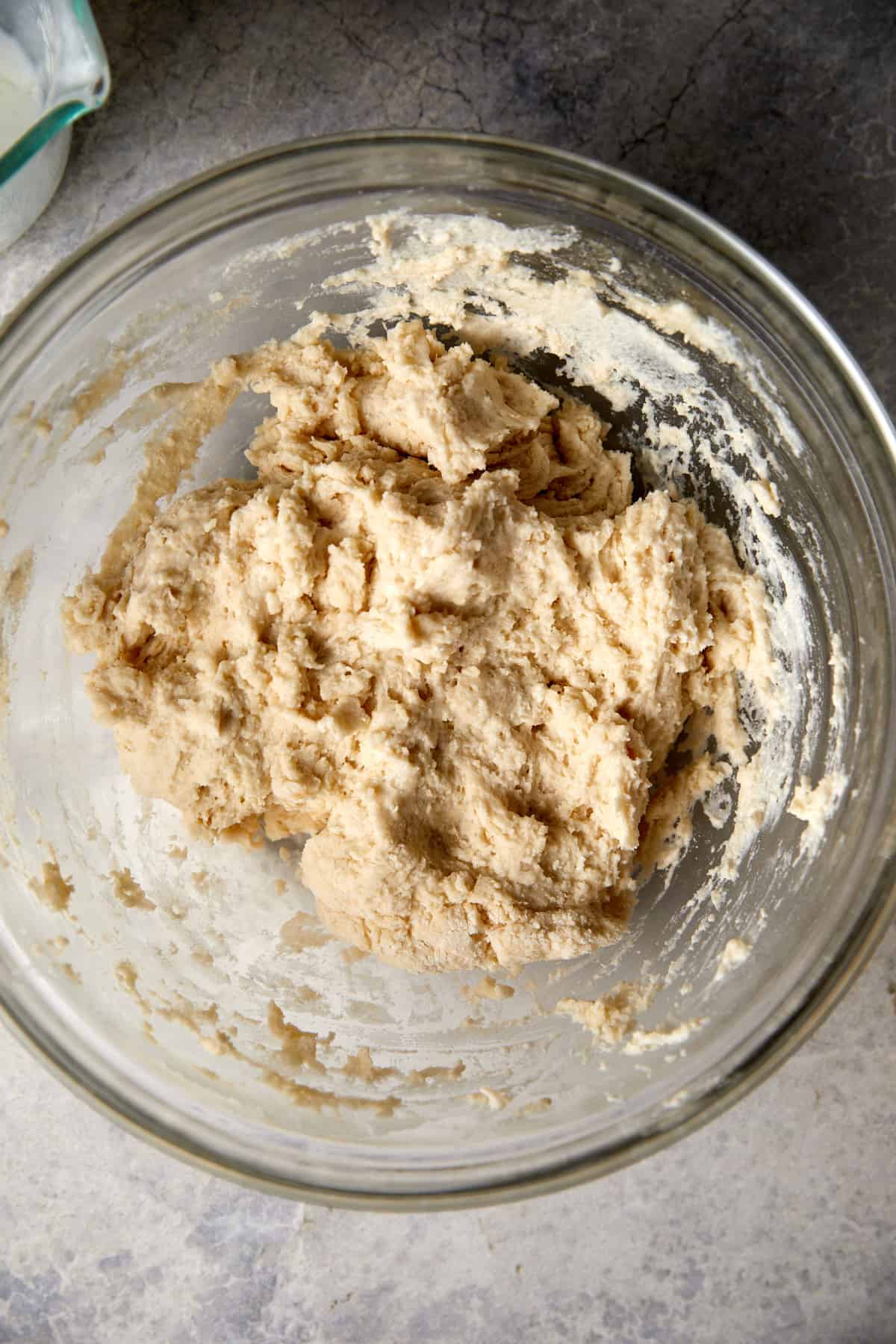
- Stir in wet ingredients. Stir in buttermilk and melted butter until just combined.
- Top. Using spoon or a cookie scoop out and drop 1-inch pieces of dough onto the filling, spaced about 1/2 inch apart.
- Spinkle. Sprinkle biscuit topping with the turbinado sugar.
- Bake Transfer skillet to a 400°F (204°C) oven and bake until biscuits are golden brown and filling is thick and glossy, 30 to 35 minutes, rotating skillet halfway through baking.
- Serve and enjoy! Serve warm, with a spoonful of ice cream, if desired.
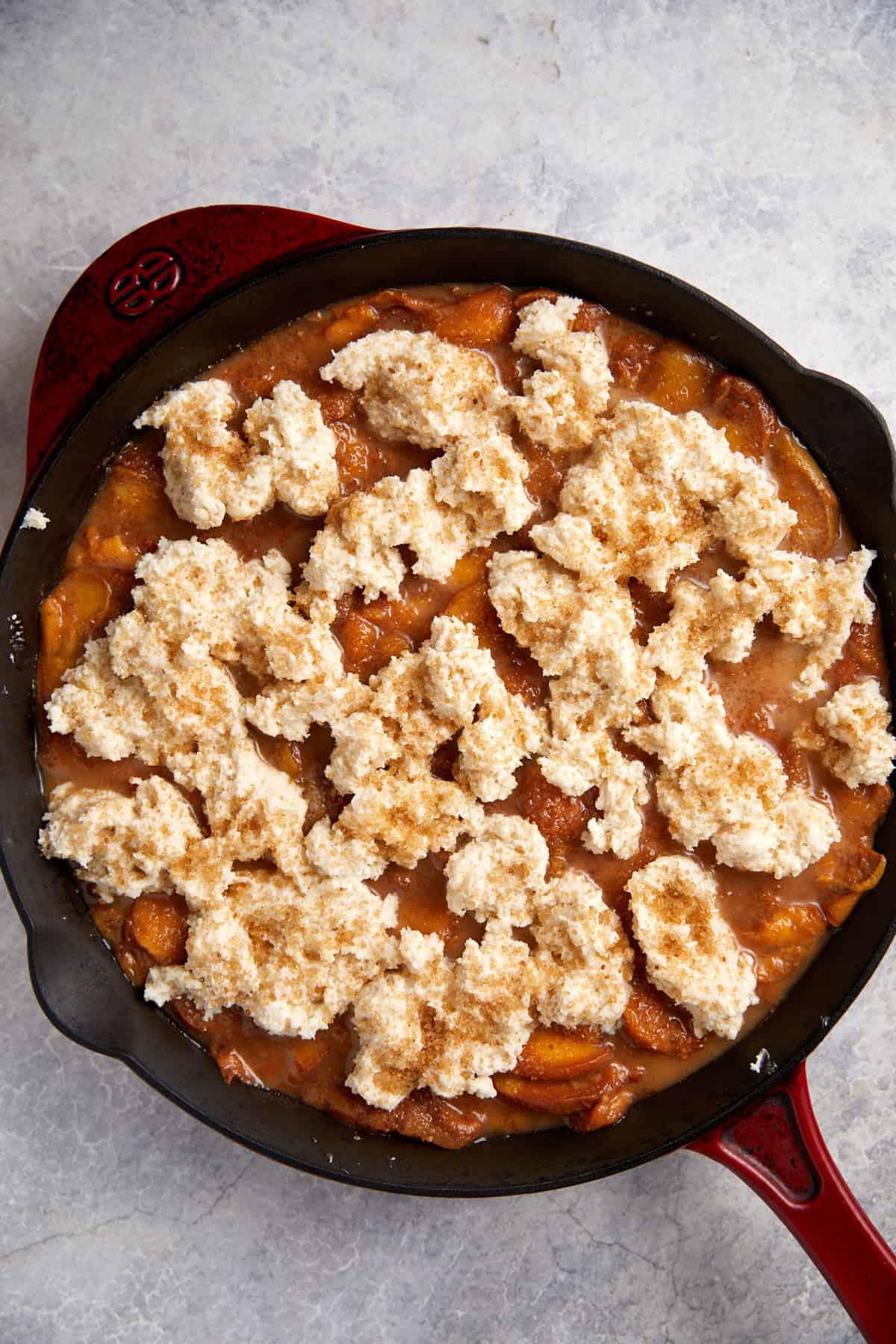
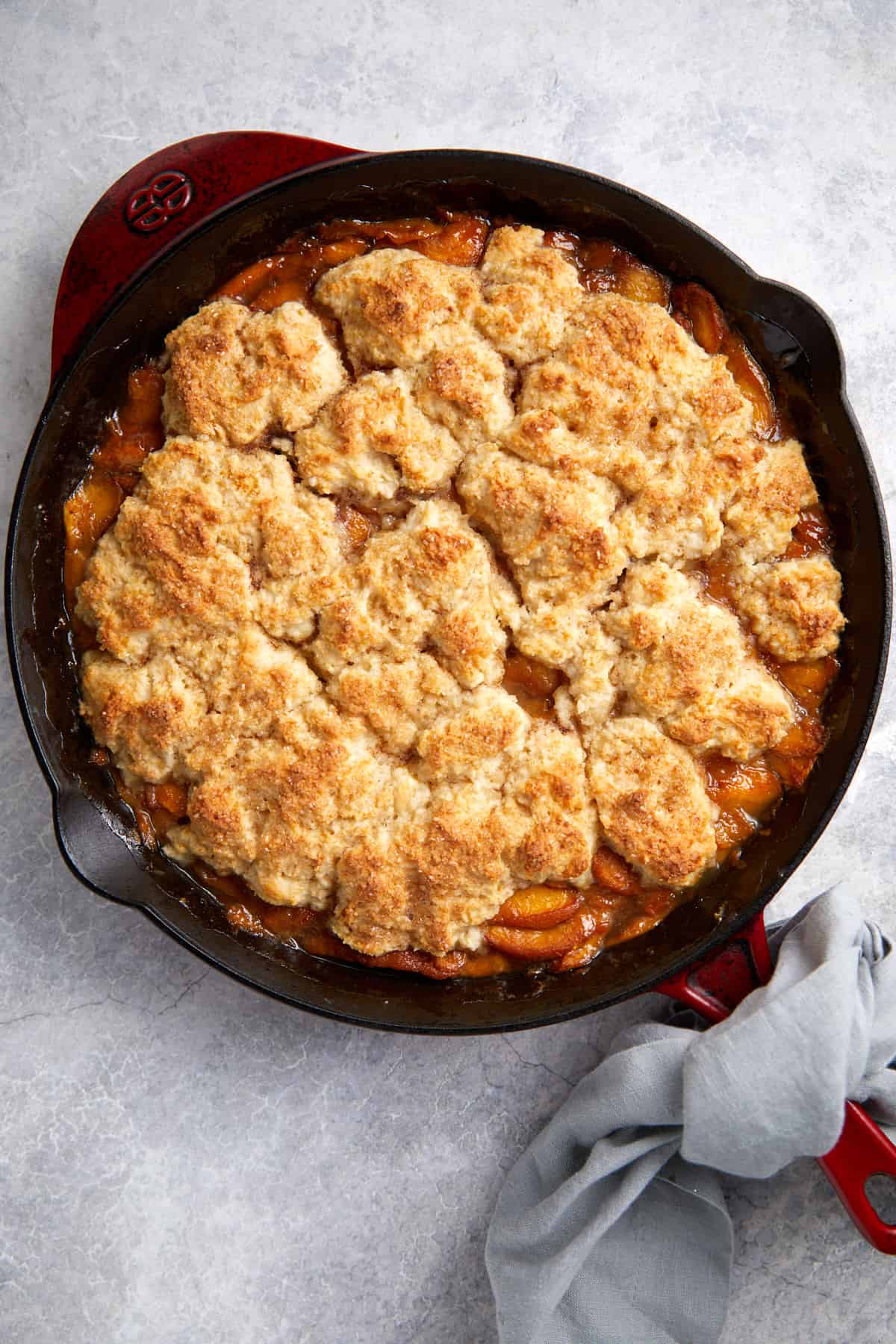
PEACH COBBLER BISCUIT TOPPING
There are numerous ways to create a delicious peach cobbler. One variation is a cake-like version, made by combining cake batter and peaches. As it bakes, the cake batter settles on the bottom and rises above the peaches. However, I personally prefer the biscuit topping, which offers a crunchy texture and a wholesome, rich taste.
Don’t worry about the arrangement of the biscuit dough on top of the peaches being exact or perfect; some of the peaches can be exposed. You can see in the picture above how much the biscuit dough will cover the peaches after baking. Just before baking, sprinkle the biscuit topping with turbinado sugar for an extra touch of flavor and texture. This is highly recommended!
HOW TO SERVE
- Vanilla ice cream: A scoop of vanilla ice cream is a classic pairing with peach cobbler, as the cold and creamy ice cream complements the warm and fruity cobbler.
- Whipped cream: Freshly whipped cream is another delicious topping for peach cobbler. It adds a light and airy texture and a subtle sweetness that complements the juicy peaches.
- Caramel sauce: Drizzling caramel sauce over peach cobbler adds a rich and decadent touch that takes the dessert to the next level.
- Fresh berries: Serving fresh berries like strawberries, blueberries, or raspberries alongside peach cobbler adds a pop of color, flavor, and texture.
- Coffee or tea: A cup of coffee or tea is a perfect beverage to enjoy with peach cobbler, as it helps balance the sweetness of the dessert.
VARIATIONS
- Blueberry Peach Cobbler: Add fresh or frozen blueberries to the sliced peaches for a delicious twist on the classic recipe.
- Almond Peach Cobbler: Add a sprinkle of almond extract to the batter for a nutty, sweet flavor.
- Ginger Peach Cobbler: Add a teaspoon of ground ginger to the batter for a spicy kick.
- Peach Cobbler with Pecans: Add chopped pecans to the batter or sprinkle them on top of the cobbler before baking for a crunchy texture.
- Peach and Raspberry Cobbler: Add fresh raspberries to the sliced peaches for a colorful and flavorful combination.
EQUIPMENT
There are two main types of surfaces found on cast iron cookware, uncoated or enameled. I use the enameled cast iron pan. Here are some explanations of both.
- Raw or uncoated cast iron: This is the traditional type of cast iron surface that has been used for centuries. Raw cast iron has a slightly rough, porous surface that allows it to develop a natural non-stick coating over time through the process of seasoning. Raw cast iron is durable, long-lasting, and provides excellent heat retention and distribution. However, it requires regular maintenance to prevent rust and maintain its non-stick properties.
- Enameled cast iron: Enameled cast iron has a smooth, non-porous surface that is coated with a layer of enamel. This makes it non-reactive, easy to clean, and resistant to rust and staining. Enameled cast iron is available in a variety of colors and finishes and is often used for baking and cooking acidic foods that could react with raw cast iron. However, enameled cast iron is not as durable as raw cast iron and can chip or crack if not handled carefully. I use an enameled cast iron pan.
STORING, FREEZING AND REHEATING
How to store leftovers?
For this recipe, it’s best to prepare and bake it right away as the biscuit topping will not rise as much if it is not immediately baked. Peach cobbler will keep on the counter, at room temperature, for at least 2 days. After 2 days, I would stick it in the fridge, for up to about 4 days. Trust me, it won’t be around long!
Freezing. You can freeze the baked cobbler for up to 3 months. After baking, let the cobbler cool completely, then transfer it to freezer-appropriate containers. Label the contents and include the current date. Freeze for up to 6 months. To reheat thaw overnight in the fridge. Place in an oven-safe dish and bake for about 20 minutes in a 350ºF preheated oven.
Reheating. Peach Cobbler is so good warmed up! To reheat the cobbler, use the microwave and reheat in 30-second increments. If you want to reheat it in the oven, bake at 350ºF for 10 minutes, if at room temperature, and about 20 minutes if the cobbler is chilled.
TOP TIPS
- Choose ripe, juicy peaches for the best flavor. The peach slices do need to be relatively the same size. Aim for slices ¼-½ inch thick so that they get nice and jammy while baking.
- Use a cast iron skillet or Dutch oven for the best results. The skillet helps to distribute heat evenly, which helps the cobbler to bake evenly and have a crispy crust.
- Make sure to evenly distribute the batter over the peaches. This will help the cobbler to bake evenly and create a crispy, golden-brown crust.
- Serve the cobbler warm with a scoop of vanilla ice cream or a dollop of whipped cream for the ultimate indulgent dessert.
- Experiment with different fruit combinations and toppings to create your own unique cobbler recipe. Don’t be afraid to get creative!
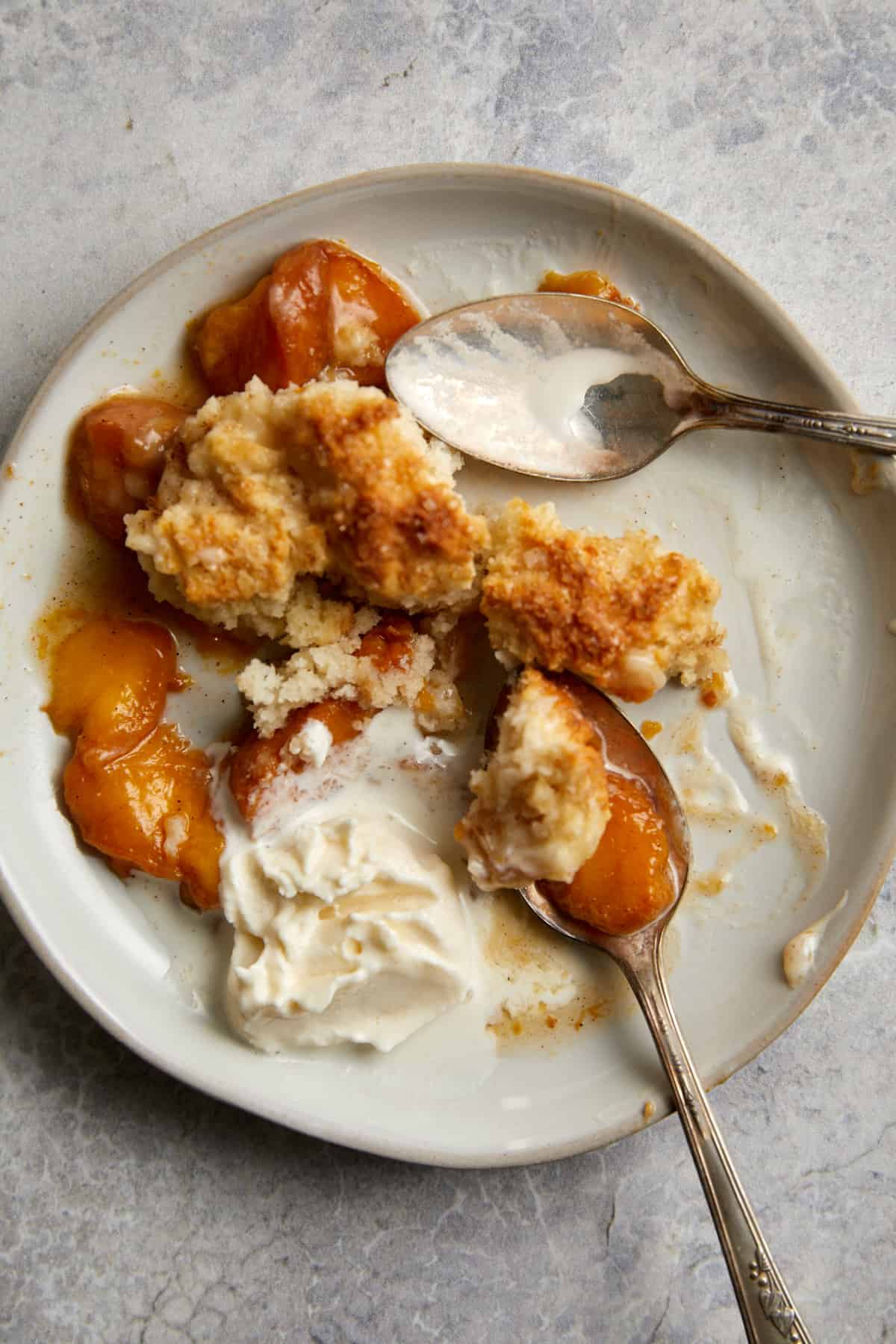
This delightful peach cobbler is a versatile dessert that’s perfect for various occasions such as holiday gatherings, summer dinner parties, BBQs, celebrations, or even as a quick weeknight treat. While it tastes amazing on its own, it reaches a whole new level of deliciousness when served with a scoop of vanilla ice cream!
FREQUENTLY ASKED QUESTIONS
Too much liquid: If you added too much liquid to the filling, or if the peaches were very ripe and released a lot of juice, this can make the cobbler filling too watery.
Underbaking: If you didn’t bake the cobbler long enough, the filling may not have thickened and the biscuit topping may not have crisped up properly.
Too much topping: If you added too much biscuit topping to the cobbler, it may not have been able to fully cook and crisp up in the oven.
To avoid a soggy peach cobbler, try reducing the amount of liquid in the filling, baking the cobbler until the filling is bubbly and the topping is golden brown and crisp, and being careful not to add too much topping.
While you can certainly use either fresh or canned peaches for cobbler, many people prefer the flavor and texture of fresh peaches. Fresh peaches tend to be more flavorful and less sweet than canned peaches, and they have a firmer texture that holds up well during baking.
That being said, using canned peaches can be a convenient option when fresh peaches are not in season or if you’re short on time. If you do choose to use canned peaches, be sure to drain them well and pat them dry with paper towels before using them in your cobbler to avoid excess liquid in the filling.
Ultimately, the choice between fresh or canned peaches comes down to personal preference and availability. If you have access to fresh, ripe peaches, they will likely give you the best flavor and texture in your cobbler. However, if you don’t have access to fresh peaches or are short on time, canned peaches can be a perfectly good option.
The decision to peel your peaches for cobbler is largely a matter of personal preference. Some people prefer the texture and appearance of peeled peaches in their cobbler, while others like the added texture and flavor that the peach skins provide.
If you do choose to leave the skins on your peaches, be sure to wash them well to remove any dirt or debris. If you decide to peel your peaches, the easiest way to do so is to blanch them in boiling water for about 30 seconds, then immediately transfer them to an ice bath to stop the cooking process. Once they’ve cooled, the skins should slip off easily.
Keep in mind that leaving the skins on your peaches can also affect the texture of your cobbler filling. Peach skins can become tough and chewy during baking, so you may want to consider cutting your peaches into smaller pieces if you plan to leave the skins on. Ultimately, the decision to peel your peaches comes down to personal preference and the desired texture of your cobbler filling.
Cornstarch is often added to cobbler recipes as a thickener for the fruit filling. When mixed with the fruit juices, cornstarch helps to absorb excess moisture and create a thicker, more syrupy consistency that holds together better in the cobbler. This helps to prevent the filling from becoming too runny or watery, which can result in a soggy or undercooked cobbler.
MORE FRUIT RECIPES YOU’LL LOVE
If you love this recipe for southern peach cobbler, try one of our other favorite fruit recipes next:
- Salted Caramel Apple Pie Bars
- Banana Nutella Muffins
- Raspberry and White Chocolate Loaf Cake
- Cinnamon Crunch Banana Bread
- Healthy Apple Muffins
After trying out this cast iron peach cobbler recipe, please do let me know your thoughts! Don’t forget to leave a comment, and if your family enjoys it as much as mine does, feel free to give it a five-star ⭐️ rating!
Cast Iron Peach Cobbler
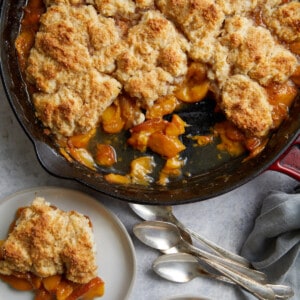
Equipment
- 1 12 inch cast iron pan
Ingredients
- 6 cups peeled and sliced peaches (7-8 peaches)
- ½ cup 100 grams granulated sugar
- 1/4 cup (28 grams) tapioca starch or 2 tablespoons corn starch
- ½ teaspoon vanilla extract
- ½ teaspoon all spice
- ¼ teaspoon nutmeg
- ½ teaspoon diamond crystal kosher salt or 1/4 teaspoon table salt
Biscuit Topping
- 1 ½ cup (213 grams) all- purpose flour
- 5 tablespoons (64 grams) granulated sugar
- 1 ½ teaspoon baking powder
- ¼ teaspoon baking soda
- 1/2 teaspoon diamond crystal kosher salt or 1/4 teaspoon table salt
- ¾ cup buttermilk
- 4 tablespoons melted butter
- 2 tablespoons turbinado sugar
Instructions
- Adjust oven rack to middle position and heat oven to 400°F (204°C).
- Stir peaches, sugar, tapioca starch, vanilla, allspice, nutmeg, and salt together in bowl until combined.
- Transfer mixture to 12-inch cast-iron skillet.
Biscuit Topping
- Whisk flour, granulated sugar, baking powder, baking soda, and salt together in medium bowl.
- Stir in buttermilk and melted butter until just combined.
- Using spoon, scoop out and drop 1-inch pieces of dough onto filling, spaced about 1/2 inch apart.
- Sprinkle biscuits with turbinado sugar.
- Transfer skillet to oven and bake until biscuits are golden brown and filling is thick and glossy, 30 to 35 minutes.
- Serve with vanilla ice cream! Enjoy!

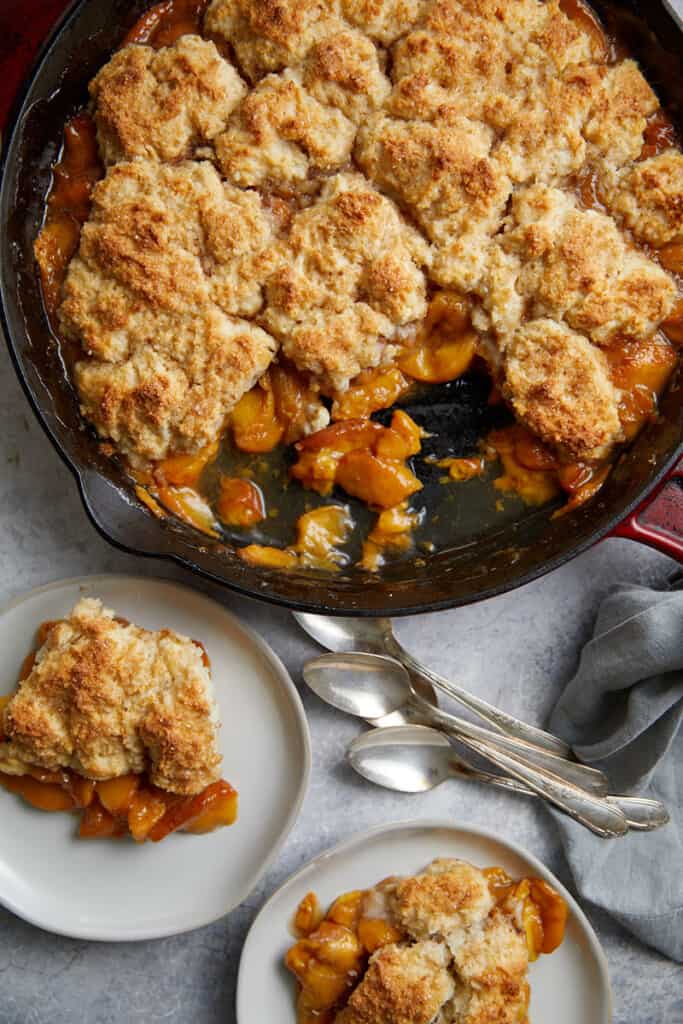
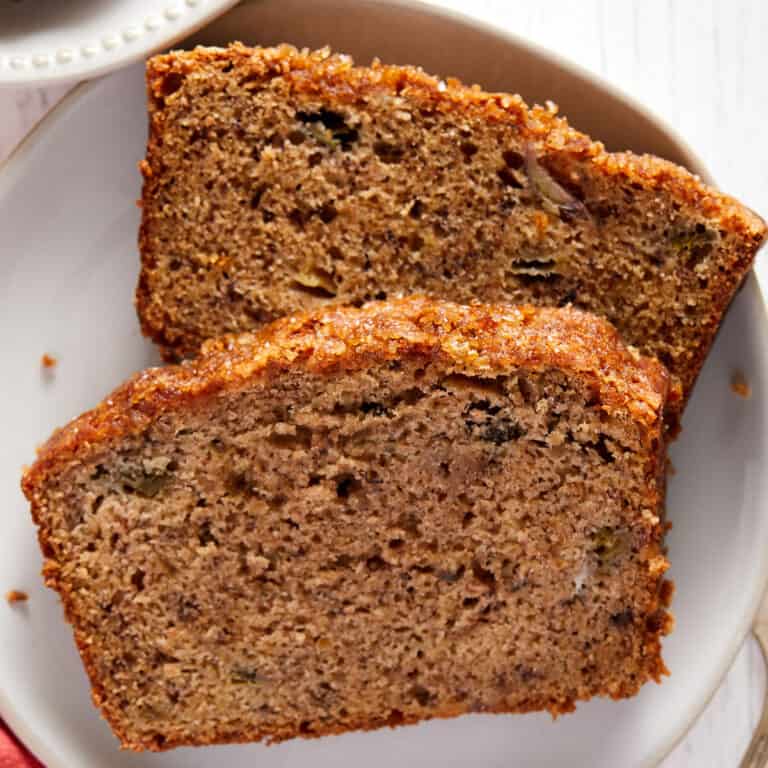
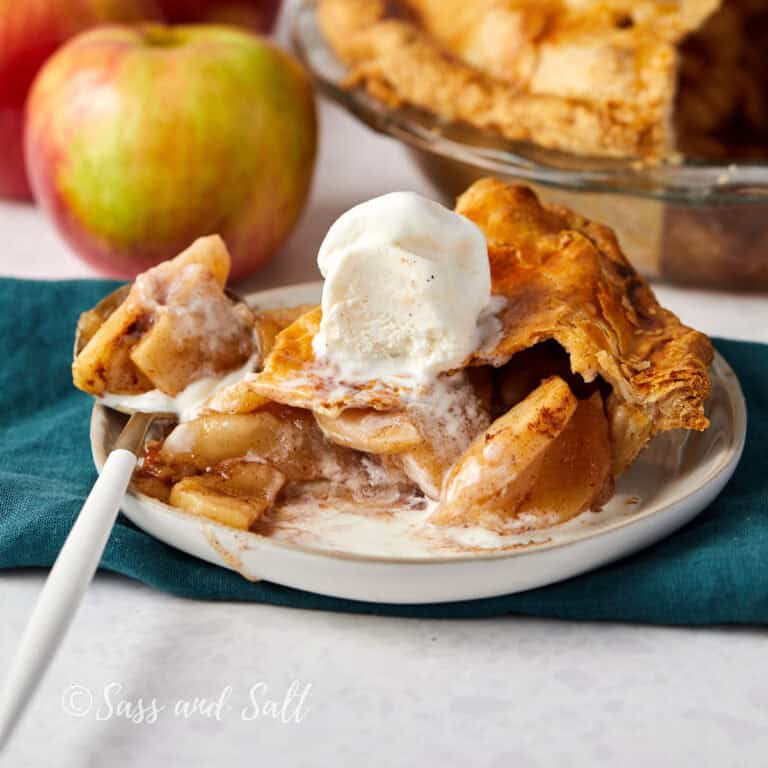
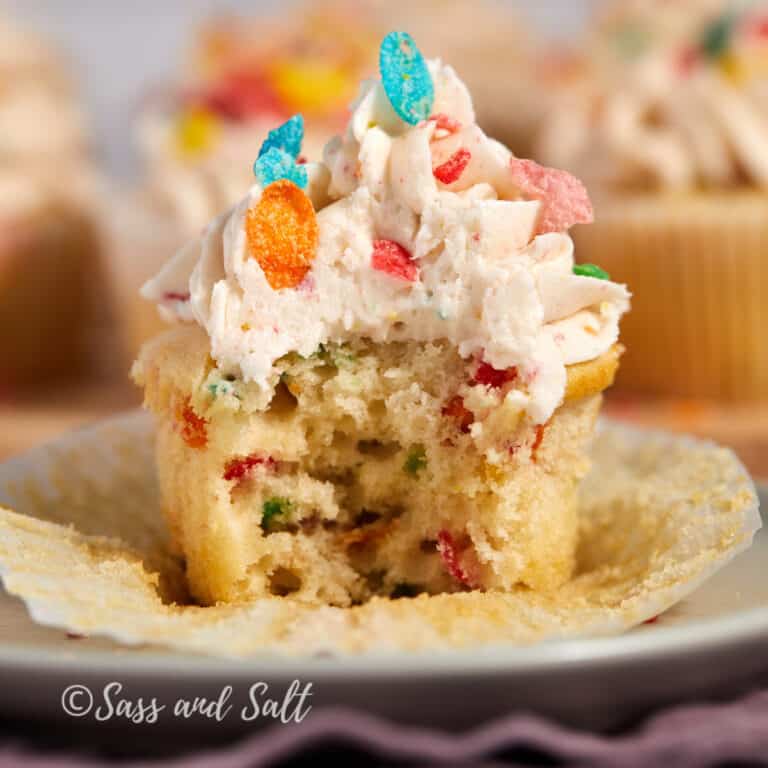
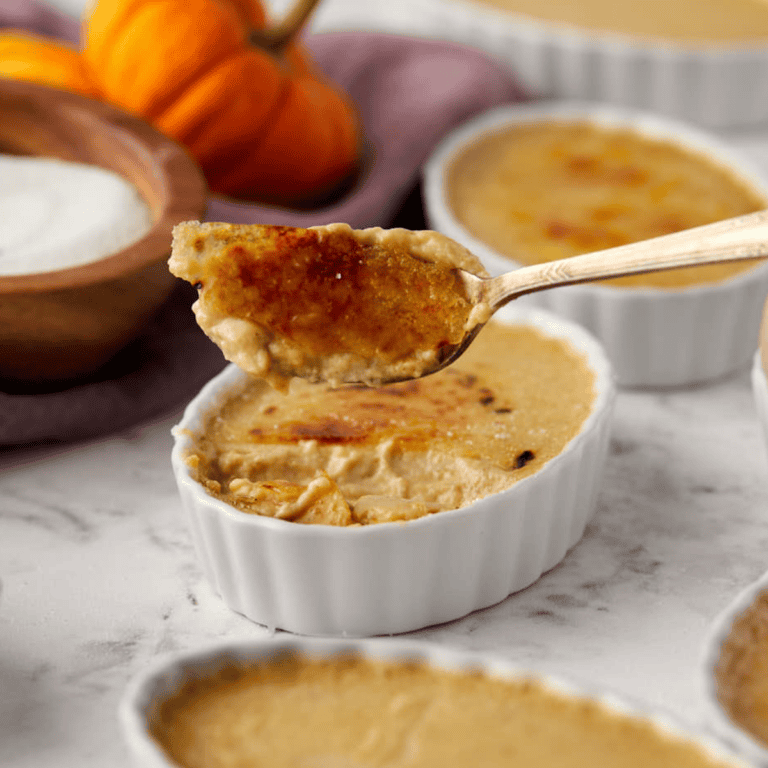
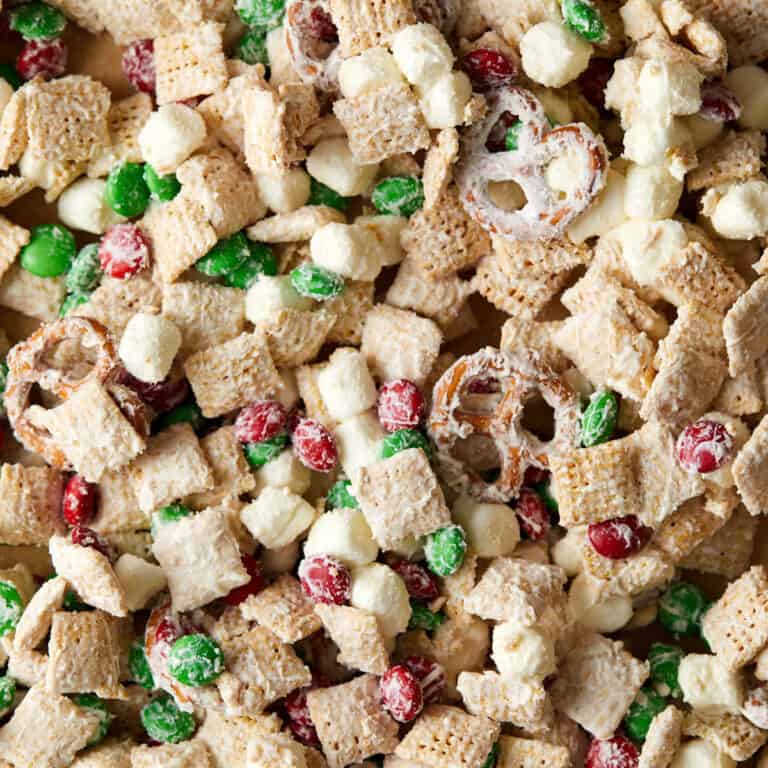
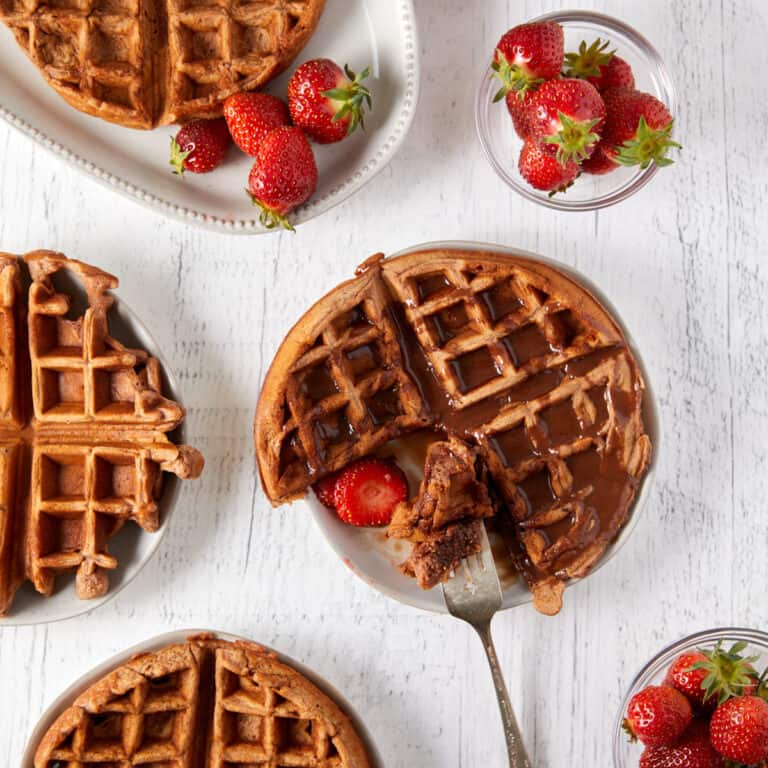
Delish. Easy to prepare.
A big time hit! I used the buttermilk substitute
The best peach cobbler I have ever had!!!